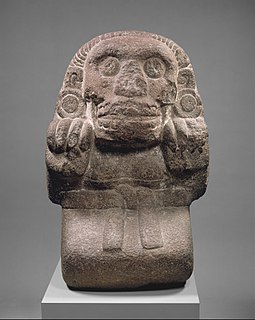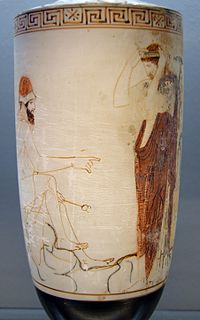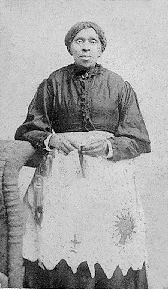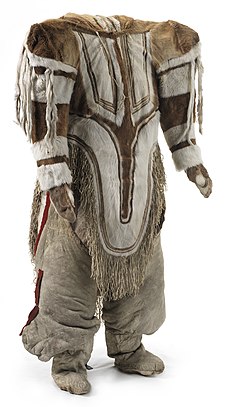Notes
Related Research Articles

Inuit religion is the shared spiritual beliefs and practices of the Inuit (Eskimo), an indigenous people from Alaska, Canada, and Greenland. Their religion shares many similarities with the Alaska Native religion. Traditional Inuit religious practices include animism and shamanism, in which spiritual healers mediate with spirits. Today many Inuit follow Christianity, but traditional Inuit spirituality continues as part of a living, oral tradition and part of contemporary Inuit society. Inuit who balance indigenous and Christian theology practice religious syncretism.

Mictlāntēcutli or Mictlantecuhtli, in Aztec mythology, was a god of the dead and the king of Mictlan (Chicunauhmictlan), the lowest and northernmost section of the underworld. He was one of the principal gods of the Aztecs and was the most prominent of several gods and goddesses of death and the underworld. The worship of Mictlantecuhtli sometimes involved ritual cannibalism, with human flesh being consumed in and around the temple.

In Aztec mythology, the Cihuateteo or "Divine Women", were the malevolent spirits of women who died in childbirth. They were likened to the spirits of male warriors who died in violent conflict, because childbirth was conceptually equivalent to battle in Aztec culture. According to tradition, a woman in labor was said to capture the spirit of her newborn child similar to the way a warrior captures his opponent in battle. These spirits are also associated with the west, the place where the sun sets each day.
In Inuit mythology, Idliragijenget is the god of the ocean.
As Idliragijenget, she is the ruler of the underworld, Adlivun. She and her father Savirqong occupy opposite sides of a large house. Since their apotheosis, they must live in the same place but keep apart that summer and winter may not get mixed...Like his daughter, he has but one eye,—the moon. The dead, seized by Anguta, are carried thither.
Sedna is the mistress of one of the countries to which the souls go after death. It has been related in the foregoing tradition of Sedna and the fulmar that she descended to Adlivun; since that time she has been the mistress of the country and when invoked as such has the name of Idliragijenget...There she lives with her father, each occupying one side of it...Like her, the father has only one eye.
The Nanai people are a Tungusic people of East Asia and the Russian Far East, who have traditionally lived along Heilongjiang (Amur), Songhuajiang (Sunggari) and Wusuli River on the Middle Amur Basin. The ancestors of the Nanai were the Jurchens of northernmost Manchuria.

The Inuit angakkuq Inuvialuktun: angatkuq; Greenlandic: angakkoq, pl.angákut) is the intellectual and spiritual figure in Inuit culture who corresponds to a medicine man. Other cultures, including Alaska Natives, have traditionally had similar spiritual mediators, although the Alaska Native religion has many forms and variants.
Kiviuq is a legendary hero of the epic stories of the Inuit of the Arctic regions of northern Canada, Alaska and Greenland.

Philippine mythology is the body of stories and epics originating from, and part of, the indigenous Philippine folk religions, which include various ethnic faiths distinct from one another. Philippine mythology is incorporated from various sources, having similarities with Indonesian and Malay myths, as well as Hindu, Muslim, Shinto, Buddhist, and Christian traditions, such as the notion of heaven, hell, and the human soul. Philippine mythology attempts to explain the nature of the world through the lives and actions of heroes, deities, and mythological creatures. The majority of these myths were passed on through oral tradition, and preserved through the aid of community spiritual leaders or shamans and community elders.

Arthur Gardiner Butler F.L.S., F.Z.S. (1844–1925) was an English entomologist, arachnologist and ornithologist. He worked at the British Museum on the taxonomy of birds, insects, and spiders.

The Mingo Oak was a white oak in the U.S. state of West Virginia. First recognized for its age and size in 1931, the Mingo Oak was the oldest and largest living white oak tree in the world until its death in 1938.

In mythology, the Greek underworld is an otherworld where souls go after death. The original Greek idea of afterlife is that, at the moment of death, the soul is separated from the corpse, taking on the shape of the former person, and is transported to the entrance of the underworld. Good people and bad people would then separate. The underworld itself—sometimes known as Hades, after its patron god—is described as being either at the outer bounds of the ocean or beneath the depths or ends of the earth. It is considered the dark counterpart to the brightness of Mount Olympus with the kingdom of the dead corresponding to the kingdom of the gods. Hades is a realm invisible to the living, made solely for the dead.

Harriet Powers was an American folk artist, and quilt maker. She was born into slavery in rural Georgia. She used traditional appliqué techniques to record local legends, Bible stories, and astronomical events on her quilts. Only two of her quilts are known to have survived: Bible Quilt 1886 and Pictorial Quilt 1898. Her quilts are considered among the finest examples of nineteenth-century Southern quilting. Her work is on display at the National Museum of American History in Washington, D.C., and the Museum of Fine Arts in Boston, Massachusetts.

Caribou Inuit, barren-ground caribou hunters, are bands of inland Inuit who lived west of Hudson Bay in Keewatin Region, Northwest Territories, now the Kivalliq Region of present-day Nunavut between 61° and 65° N and 90° and 102° W in Northern Canada. They were originally named "Caribou Eskimo" by the Danish Fifth Thule Expedition of 1921-4 led by Knud Rasmussen. Caribou Inuit are the southernmost subgroup of the Central Inuit.

Captain George Comer was considered the most famous American whaling captain of Hudson Bay, and the world's foremost authority on Hudson Bay Inuit in the early 20th century.
Utkuhiksalik, Utkuhikhalik, Utkuhikhaliq, Utkuhiksalingmiutitut, Utkuhiksalingmiutut, Utkuhiksalingmiut Inuktitut, Utku, Gjoa Haven dialect, is a sub-dialect of Natsilingmiutut (Nattiliŋmiut) dialect of Inuvialuktun language once spoken in the Utkuhiksalik area of Nunavut, and now spoken mainly by elders in Uqsuqtuuq and Qamani'tuaq on mainland Canada. It is generally written in Inuktitut syllabics.

Yup'ik clothing refers to the traditional Eskimo-style clothing worn by the Yupik people of southwestern Alaska. Also known as Cup'ik clothing for the Chevak Cup'ik-speaking people of Chevak and Cup'ig clothing for the Nunivak Cup'ig-speaking people of Nunivak Island.
Quidlivun is a small depression on the surface of Pluto corresponding to the central caldera of Wright Mons, southwest of the Tenzing Montes and adjacent to Morgoth Macula. It was discovered by the New Horizons spacecraft in 2015 and informally named after the Inuit land of the dead on the Moon.

Yup'ik cuisine refers to the Eskimo style traditional subsistence food and cuisine of the Yup'ik people from the western and southwestern Alaska. Also known as Cup'ik cuisine for the Chevak Cup'ik dialect speaking Eskimos of Chevak and Cup'ig cuisine for the Nunivak Cup'ig dialect speaking Eskimos of Nunivak Island. This cuisine is traditionally based on meat from fish, birds, sea and land mammals, and normally contains high levels of protein. Subsistence foods are generally considered by many to be nutritionally superior superfoods. Yup’ik diet is different from Alaskan Inupiat, Canadian Inuit, and Greenlandic diets. Fish as food are primary food for Yup'ik Eskimos. Both food and fish called neqa in Yup'ik. Food preparation techniques are fermentation and cooking, also uncooked raw. Cooking methods are baking, roasting, barbecuing, frying, smoking, boiling, and steaming. Food preservation methods are mostly drying and less often frozen. Dried fish is usually eaten with seal oil. The ulu or fan-shaped knife used for cutting up fish, meat, food, and such.

The ancient Mesopotamian underworld, most often known in Sumerian as Kur, Irkalla, Kukku, Arali, or Kigal and in Akkadian as Erṣetu, although it had many names in both languages, was a dark, dreary cavern located deep below the ground, where inhabitants were believed to continue "a shadowy version of life on earth". The only food or drink was dry dust, but family members of the deceased would pour libations for them to drink. Unlike many other afterlives of the ancient world, in the Sumerian underworld, there was no final judgement of the deceased and the dead were neither punished nor rewarded for their deeds in life. A person's quality of existence in the underworld was determined by his or her conditions of burial.

The traditional skin clothing of the Inuit is a complex system of cold-weather garments historically made from animal hide and fur, worn by the Inuit, a group of culturally related indigenous peoples inhabiting the Arctic. Despite the wide distribution of the various Inuit peoples across regions of North America and Greenland, traditional garments are broadly consistent in both design and material, due to the common need for protection against the extreme weather of the polar regions and the limited range of materials suitable for the purpose. Production of warm, durable clothing was an essential survival skill for the Inuit, which was traditionally passed down from adult women to girls. The creation and use of skin clothing had important spiritual implications for the Inuit.
References
Bibliography
- Boas, Franz (1888). Smithsonian Institution (ed.). The Central Eskimo: Sixth Annual Report of the Bureau of Ethnology to the Secretary of the Smithsonian Institution, 1884-1885. Washington (District of Columbia), USA: Government Printing Office. OCLC 16737743 – via Project Gutenberg.
- Gabryl, Franciszek (1895). Skład Główny w Księgarni G. Gebethnera i spółki (ed.). Nieśmiertelność duszy ludzkiej w świetle rozumu i nowoczesnej nauki [The human soul's immortality enlightened through reason and modern science] (in Polish). Kraków, PL: Druk. Wł. L. Anczyc i Sp. oai:rcin.org.pl:1834 – via RCIN-IGIPZ - Digital Repository of Scientific Institutions.
- Leach, Maria (1954). The Beginning: Creation Myths Around the World. New York City (New York), USA: Funk & Wagnalls. OCLC 528661 – via Google Books.